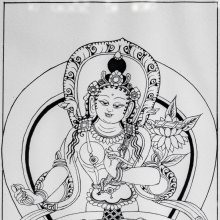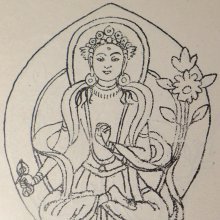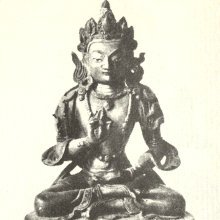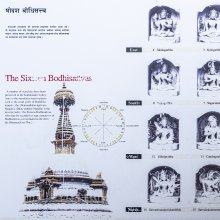Vajragarbha: 6 definitions
Introduction:
Vajragarbha means something in Buddhism, Pali, Hinduism, Sanskrit. If you want to know the exact meaning, history, etymology or English translation of this term then check out the descriptions on this page. Add your comment or reference to a book if you want to contribute to this summary article.
Images (photo gallery)
In Buddhism
Tibetan Buddhism (Vajrayana or tantric Buddhism)
Source: archive.org: The Indian Buddhist Iconography1) Vajragarbha (वज्रगर्भ) (“matrix of thunderbolt”) is the name of a Bodhisattva commonly depicted in Buddhist Iconography, and mentioned in the 11th-century Niṣpannayogāvalī of Mahāpaṇḍita Abhayākara.—his color is blue or bluish white ; his symbol is the Daśabhūmika scripture.—
Vajragarbha is described in the Niṣpannayogāvalī as follows:—
(1: Dharmadhatūvāgīśvara-maṇḍala):—“Vajragarbha is of the colour of the petal of a blue lotus and holds in the right hand the Vajra and in the left the book called the Daśabhūmika”. (2: Durgatipariśodhana-maṇḍala):—“Vajragarbha is of bluish white colour and holds the blue lotus in the right hand while the clenched left rests on the hip”.
2) Vajragarbha (वज्रगर्भ) or Vajragarbhalokeśvara refers to number 45 of the 108 forms of Avalokiteśvara found in the Machhandar Vahal (Kathmanu, Nepal). [Machhandar or Machandar is another name for for Matsyendra.].
Accordingly,—
“Vajragarbha also has the same number of hands and faces as No. 44. He holds the Vajra in his right hand and the stem of a lotus in his left”.
The names of the 108 deities [viz., Vajragarbha] possbily originate from a Tantra included in the Kagyur which is named “the 108 names of Avalokiteshvara”, however it is not yet certain that this is the source for the Nepali descriptions.Source: Brill: Śaivism and the Tantric Traditions (tantric Buddhism)
Vajragarbha (वज्रगर्भ) refers to one of the sixteen Bhadrakalpa Bodhisattvas, according to the Niṣpannayogāvalī 44ff and Abhayākaragupta’s Durgatipariśodhana-maṇḍala (Cf. Niṣpannayogāvalī 66ff.).—A set of sixteen Bodhisattvas often supplements the deities of the Tattvasaṃgraha in later Vajradhātu-maṇḍala descriptions. These are generally the sixteen Bodhisattvas of the present aeon (bhadrakalpa) [e.g., Vajragarbha], as described for example in Abhayākaragupta’s Niṣpannayogāvalī Vajradhātu-maṇḍala.—Cf. also Nāmamantrārthāvalokinī and Abhayākaragupta’s forty-three deity Mañjuvajra-maṇḍala (Tricatvāriṃśadātmakamañjuvajra-maṇḍala: see Niṣpannayogāvalī 50)

Tibetan Buddhism includes schools such as Nyingma, Kadampa, Kagyu and Gelug. Their primary canon of literature is divided in two broad categories: The Kangyur, which consists of Buddha’s words, and the Tengyur, which includes commentaries from various sources. Esotericism and tantra techniques (vajrayāna) are collected indepently.
Mahayana (major branch of Buddhism)
Source: academia.edu: A Study and Translation of the GaganagañjaparipṛcchāVajragarbha (वज्रगर्भ) refers to the “essence of diamond”, according to the Gaganagañjaparipṛcchā: the eighth chapter of the Mahāsaṃnipāta (a collection of Mahāyāna Buddhist Sūtras).—Accordingly, “The venerable Ānanda said this to the Lord: ‘O Lord, when will the wicked māra wake up to incomparable complete awakening? What will he be called after having attained the awakening? And what will be the name of that universe?’ The Lord said: ‘Ānanda, the wicked Māra, doing the works of the māra in the Buddha-fields of ten directions again and again, will hear the dharma of destroying vices by the essence of diamond (vajragarbha) from the awakened Buddhas there, and will see the secret practice, behaviour, good qualities, maintaining morality, practice, ceremony and application of the Buddhas and the Bodhisattvas. [...]’”.

Mahayana (महायान, mahāyāna) is a major branch of Buddhism focusing on the path of a Bodhisattva (spiritual aspirants/ enlightened beings). Extant literature is vast and primarely composed in the Sanskrit language. There are many sūtras of which some of the earliest are the various Prajñāpāramitā sūtras.
Languages of India and abroad
Sanskrit dictionary
Source: Cologne Digital Sanskrit Dictionaries: Edgerton Buddhist Hybrid Sanskrit DictionaryVajragarbha (वज्रगर्भ).—name of a Bodhisattva: Mahāvyutpatti 663; Daśabhūmikasūtra 2.4, 26 ff., etc.
Source: Cologne Digital Sanskrit Dictionaries: Monier-Williams Sanskrit-English DictionaryVajragarbha (वज्रगर्भ):—[=vajra-garbha] [from vajra > vaj] m. Name of a Bodhisattva, [Buddhist literature]
[Sanskrit to German]
Sanskrit, also spelled संस्कृतम् (saṃskṛtam), is an ancient language of India commonly seen as the grandmother of the Indo-European language family (even English!). Closely allied with Prakrit and Pali, Sanskrit is more exhaustive in both grammar and terms and has the most extensive collection of literature in the world, greatly surpassing its sister-languages Greek and Latin.
See also (Relevant definitions)
Partial matches: Vajra, Garbha.
Starts with: Vajragarbhalokeshvara.
Full-text (+30): Hevajrapindarthatika, Vama, Seka, Abhedya, Bhavaki, Maradarika, Usma, Geha, Hrishta, Vishta, Vajragarbhalokeshvara, Dosha, Siddha, Divya, Lalana, Surupini, Vamani, Kamini, Sharvari, Shitada.
Relevant text
Search found 7 books and stories containing Vajragarbha, Vajra-garbha; (plurals include: Vajragarbhas, garbhas). You can also click to the full overview containing English textual excerpts. Below are direct links for the most relevant articles:
The Indian Buddhist Iconography (by Benoytosh Bhattachacharyya)
Cosmetics, Costumes and Ornaments in Ancient India (by Remadevi. O.)
2.2. Various other Ear Ornaments < [Chapter 3 - Ornaments]
Bodhisattvacharyavatara (by Andreas Kretschmar)
Text Sections 177-178 < [Khenpo Chöga’s Oral Explanations]
Blue Annals (deb-ther sngon-po) (by George N. Roerich)
Chapter 29 - Sonam Gyatso (viii): Paranirvāṇa < [Book 10 - The Kālacakra]
Chapter 29 - Sonam Gyatso (vii): Labors for the doctrine < [Book 10 - The Kālacakra]
Buddha-nature (as Depicted in the Lankavatara-sutra) (by Nguyen Dac Sy)
6. The Other Power (adhiṣṭhāna) < [Chapter 5 - The Practice of Buddha-Nature in the Laṅkāvatārasūtra]
A Dictionary Of Chinese Buddhist Terms (by William Edward Soothill)

.jpg)



